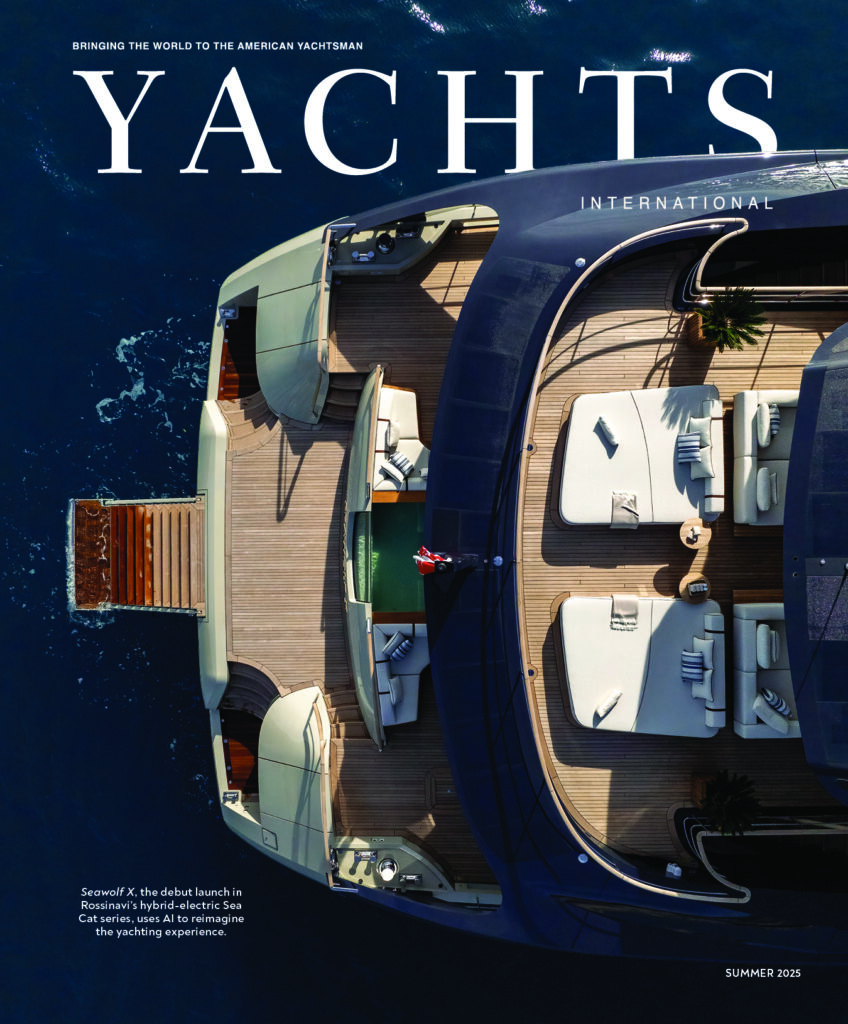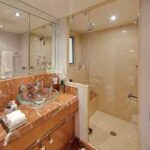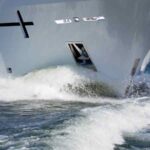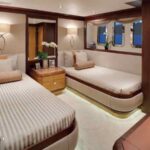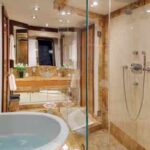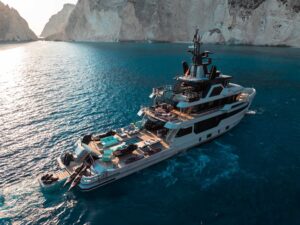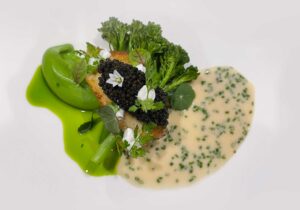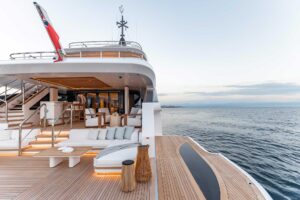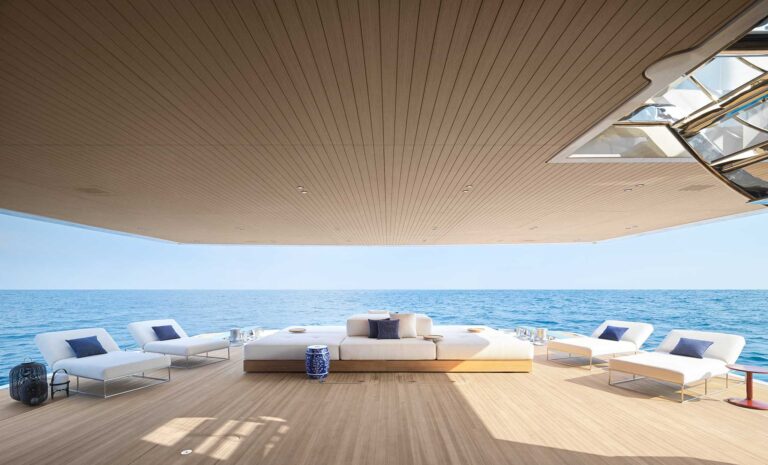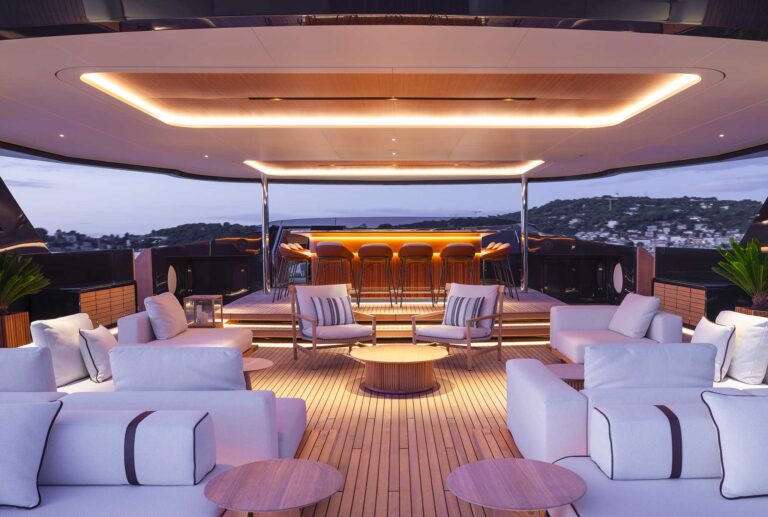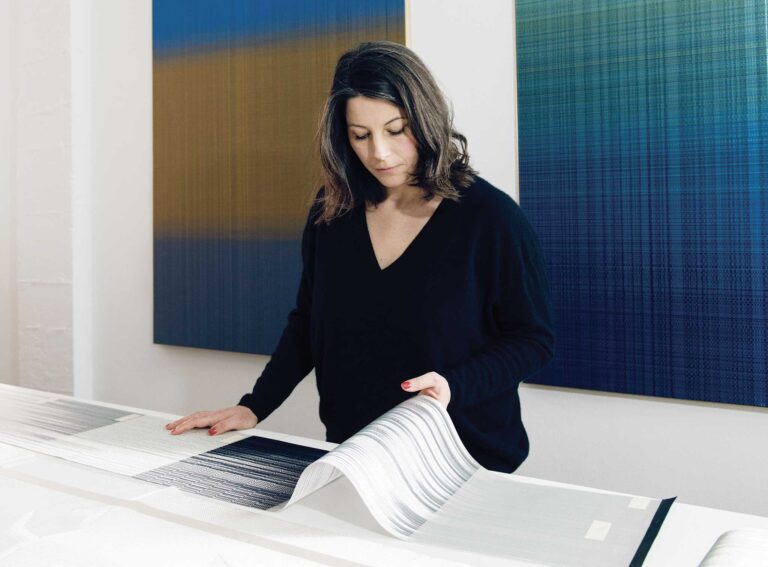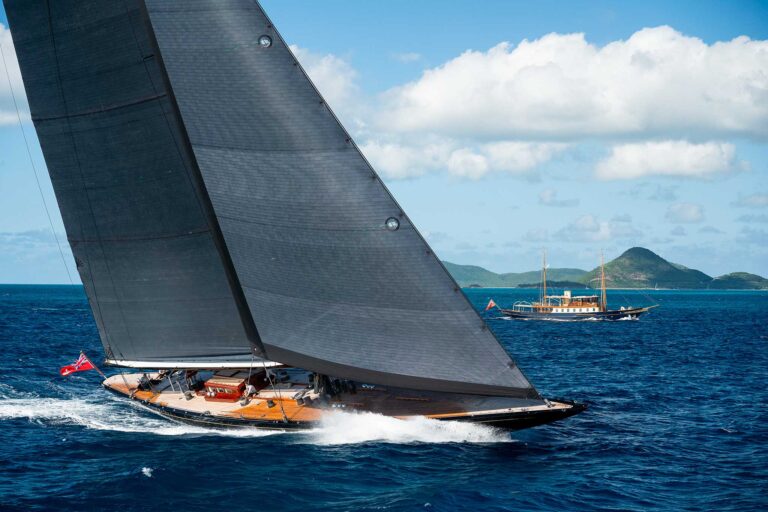https://www.youtube.com/watch?v=4IFGONSHw7U
Ocean Alexander, with the launch of its OA 120, opens a new chapter in its 34-year history. The alluring new flagship was developed over a period of five years—from the first conversation with designer Evan K. Marshall—and debuts at the 2012 Fort Lauderdale International Boat Show in October.
Photos Stephen Cridland

A product of the unexpected and successful collaboration between two well-known but vastly different yachtbuilders—Ocean Alexander and Christensen Shipyards—the OA 120 is an interesting yacht through and through and certainly one of the must-sees at this year’s Fort Lauderdale show.
What’s so interesting about it? First, it already has history. About five years ago, Ocean Alexander’s young and energetic Chairman John Chueh reached out to a designer with global reputation and superyacht experience, the multi-talented and approachable Marshall, to come up with a concept for a new yacht that would move the needle forward for Ocean Alexander. “From the onset the idea was to create a boat that gave Ocean Alexander a new identity and more international appeal,” Marshall says.
Since Ocean Alexander founder Alexander Chueh (John’s father) got into the boatbuilding business in 1978, the company has had great success developing an American clientele, particularly on the US West Coast. On a global scale, Taiwan is not so far from there and the company developed close ties within the region. Ocean Alexander’s longtime collaborator, naval architect Ed Monk Jr., lives near Seattle, where the multifaceted company also owns two marinas and a successful dealership. The boats’ large galleys, comfortable cabins and classic interiors are appealing to American boaters. There is nothing wrong with preaching to the choir, so to speak, but there is a challenge inherent with selling a well-built product that can last for decades. Sooner or later, in order to grow, a company needs to go after new markets, something Ocean Alexander is doing by expanding its offering through marketing agreements with other brands.
In addition, in recent years, the company made tweaks to a number of its models (currently ranging from 62 to 102 feet) to expand its brand’s appeal without losing its core clientele. In September 2009, for instance, Ocean Alexander chose the Cannes International Boat and Yacht Show to introduce its new 83 Motoryacht. That was no coincidence. The boat’s clean lines and contemporary interior were specifically developed to appeal to European sensibilities. With the new flagship-to-be, clearly Ocean Alexander intended to take a bolder step in the same direction.
Chairman Chueh has been at the helm of Ocean Alexander for 13 years. His vision for the company includes a diversified marine business able to make strategic alliances in order to grow the brand, which he considers to be the company’s most valuable asset. Manufacturing only represents about one third of Ocean Alexander’s current revenue today, he says. So he was comfortable seeking a shipyard to build this high-stakes new model.

Ocean Alexander’s Director of US Operations Richard Allender and Jeffery Ferguson—an experienced boatbuilder, former Christensen executive and now Ocean Alexander’s VP of product development—sowed the seeds of a potential collaboration with the reputed composite yachtbuilder in Vancouver, Wash. By then, Christensen had discovered, like many others did, that the superyacht business was not recession-proof. Reacting swiftly to the downturn, in 2009, the management created a new company to manufacture high-tech composite parts for the wind and waves industries and implemented new lean-manufacturing procedures to keep its overhead low. Another opportunity soon presented itself.
“Back in 2009, Jeff and I starting talking,” says Joe Foggia, president of Christensen Shipyards. “Richard had asked if we would be interested in building the 120.” Ocean Alexander had already come to the decision they wanted to build in the United States, and it did not take very long for an agreement to be penned. The announcement may have surprised many in the yachting industry, but the business arrangement made perfect sense for the two companies.
“It was a no-brainer for me.” Foggia says. “The yachtbuilding industry was pretty much on the ropes at that time. We took four months to formulate all the plans and get into the nuts and bolts.” Starting with a 115, the companies ended up agreeing on a 121-foot yacht. In order to make sense financially, the agreement had to be for the construction of more than one boat. After reviewing the project carefully, Christensen agreed to build three Ocean Alexanders to start. “The hull design was tank tested. Our naval architects went through everything and basically reassured everybody that, based off estimates, it should do what they say it is going to do,” Foggia says.
Christensen’s engineers began working in earnest while the mold construction proceeded in Kaohsiung. In June 2010, the mold arrived in Vancouver, and Ferguson began making frequent trips to Vancouver to oversee the construction, which, from all accounts, went very smoothly from the time work began on the hull and superstructure to final outfitting.
The yacht itself is also quite interesting. The OA 120 is an alluring superyacht in a compact envelope with a smartly laid-out interior encompassing 3,300 square feet of air-conditioned space. “She is a little jewel of a motoryacht,” says Marshall, who had just returned to his London office from a final trip to Vancouver where he saw the final furniture installation and styling. “I have always been an admirer of Christensen yachts, everything from the mechanics to the furniture is top quality. She is going to be a stunning OA/Christensen. She really is both yards.”

The generously proportioned hull and superstructure accommodates five staterooms (including a full-beam ondeck master stateroom), a large eat-in galley, formal dining, an attractive wheelhouse with walkaround leather settee, a captain’s cabin, a Jacuzzi, a garage able to accommodate a 15-foot 8-inch tender plus an integrated deck crane with a 3,500-pound lift capability. Thoroughly engineered and built to class (MCA and ABS), she features all the systems found on bigger boats. It’s impossible to list them all, but here is a sample: stern and bow thrusters, dual stainless-steel anchor pocket for two Maxwell anchors with 450 feet of anchor steel chain, two 76kW Caterpillar generators, zero-speed stabilizers, an Atlas shore-power management system that adapts to local voltage, a large watermaker that works through osmosis, integrated diesel fuel tanks, a separate gas tank for water toys, underwater exhaust and water discharge. The engines are two compact 1,450hp MTU 12V 2000 M72 commercial engines, which Ferguson chose for their longevity and efficiency.
I have been following Ferguson, taking notes furiously on my notepad as he ticks off all the points of this very fine yacht’s technical aspects. Cupro-nickel pipes. Check. Perfectly matched and polished diamond aluminum plates. Check.
“The whole boat is built to Christensen’s standards,” Ferguson says as we step out of the immaculate engine room. On the outside, he points to the hull shape. It has a fine entry but nicely rounded tumblehomes that create more room inside. The keel comes down below the two five-blade propellers for added protection. The OA 120 is built to be a seakindly boat with about 3,000 nautical miles of range.
Quality engineering notwithstanding, most everyone seeing the yacht for the first time will focus on Marshall’s superb styling. Modern without being radical, it produces a perfectly balanced profile with attractive vertical portholes and a vertical wraparound windshield. Just below the windshield is a lovely seating area and a table overlooking the foredeck. The hardtop sheltering a table and banquette seating finishes the boat off perfectly.
The OA 120 was built on spec, always a bit of a challenge for the builder who needs to try and anticipate what buyers will like. This influenced the interior design decision. “My suggestion was to go with a more contemporary and cleaner look for the joinery,” Marshall says. Still, he did not want to go too far in one direction so as not to alienate the traditional Ocean Alexander buyer. Black walnut and maple in a satin finish and a selection of fabrics in muted earth tones lend the yacht a bit of a masculine feel. It is contemporary, but not radically so. The idea is that, depending on the artwork and the furniture an owner chooses, the interior can end up being more modern or more classic. Regardless, when she takes to the sea, passengers will probably focus their gaze on the environment.

“We went for large windows, with a lot of light coming into the salon and into the master, which has big vertical windows,” Marshall says. To emphasize the light and give the yacht the feel of a home, he also opted for low-profile furnishings that look as if they stand on their own. “And as a nod to what American buyers have really welcomed, we went for a real country kitchen. That was a bit of a challenge because the midship galley is often not very large, but we succeeded. Owners who enjoy cooking have plenty of space to do that. They can sit down with the family and eat in the galley and sit on the big settee next to the large windows,” Marshall says.
Christensen does all joinery and cabinetry in-house. A few years ago, it added a marble shop and brought all the stonework in-house as well. The shipyard has built classic high-gloss interiors and at least one much more modern interior. So its craftsmen can do just about anything and do it really well.
One of the yacht’s assets is certainly the logical flow between decks. Crew and guests can use different passageways (the main galley for instance has a side entry door) and lower guest cabins have direct access to the crew area. All decks are finished in teak. The stairs are easy to climb and there is plenty of room to lounge around on the private sun deck and the bridge deck aft, where another dining area is located. I can’t think of anything missing from this alluring little ship.
Foggia is confident buyers will embrace this new model and he is happy to build two or three Ocean Alexanders a year along with the shipyard’s 164-foot custom series. As for Chueh, he is satisfied with his choice of a builder. “There is a lot of cache and brand equity in Christensen,” he says. “There has been a lot of feedback and forth,” he says. From Christensen, Ocean Alexander has seen a better way to deal with exhaust systems and Christensen has seen Ocean Alexander’s weight-saving technology. “I think it has been a fruitful relationship on both fronts.”
It is likely that the debut of the OA 120, which is a very interesting and well-built yacht, will spur interest in the two larger yachts the builders have already discussed together: an Ocean Alexander 135 and the Ocean Alexander 155 by Christensen.
For more information, visit oceanalexander.com and christensenyachts.com.
LOA: 121ft. 2in. (36.93m)
LWL: 102ft. 10in. (31.3m)
Beam: 25ft. 2in. (7.65m)
Draft (full load): 6ft. 7in. (2m)
Displacement (full load): 215 tons
Material (hull/superstructure): composite
Arch: aluminum
Speed (cruising): 16.5 knots
Range: 3,000 nm
Fuel capacity (long range): 7,000 gal. (26,497L )
Freshwater capacity: 1,200 gal. (4,543L)
Engines: 2 x MTU 12V 2000 M72
Generators: Twin Caterpillar C4.4 76kW
Bow/stern thrusters: ABT TRAC 16-inch dual prop
Stabilizers: ABT Trac fin zero-speed stabilizers
Paint: Awlgrip Matterhorn White
Exterior design: Evan K. Marshall
Interior design: Evan K. Marshall
Engineering/Naval architecture: Christensen Yachts
Builder: Christensen Yachts
Owner & guest staterooms: 10 guests in 5 staterooms
Crew quarters: 7 – 8 crew in 4 cabins


